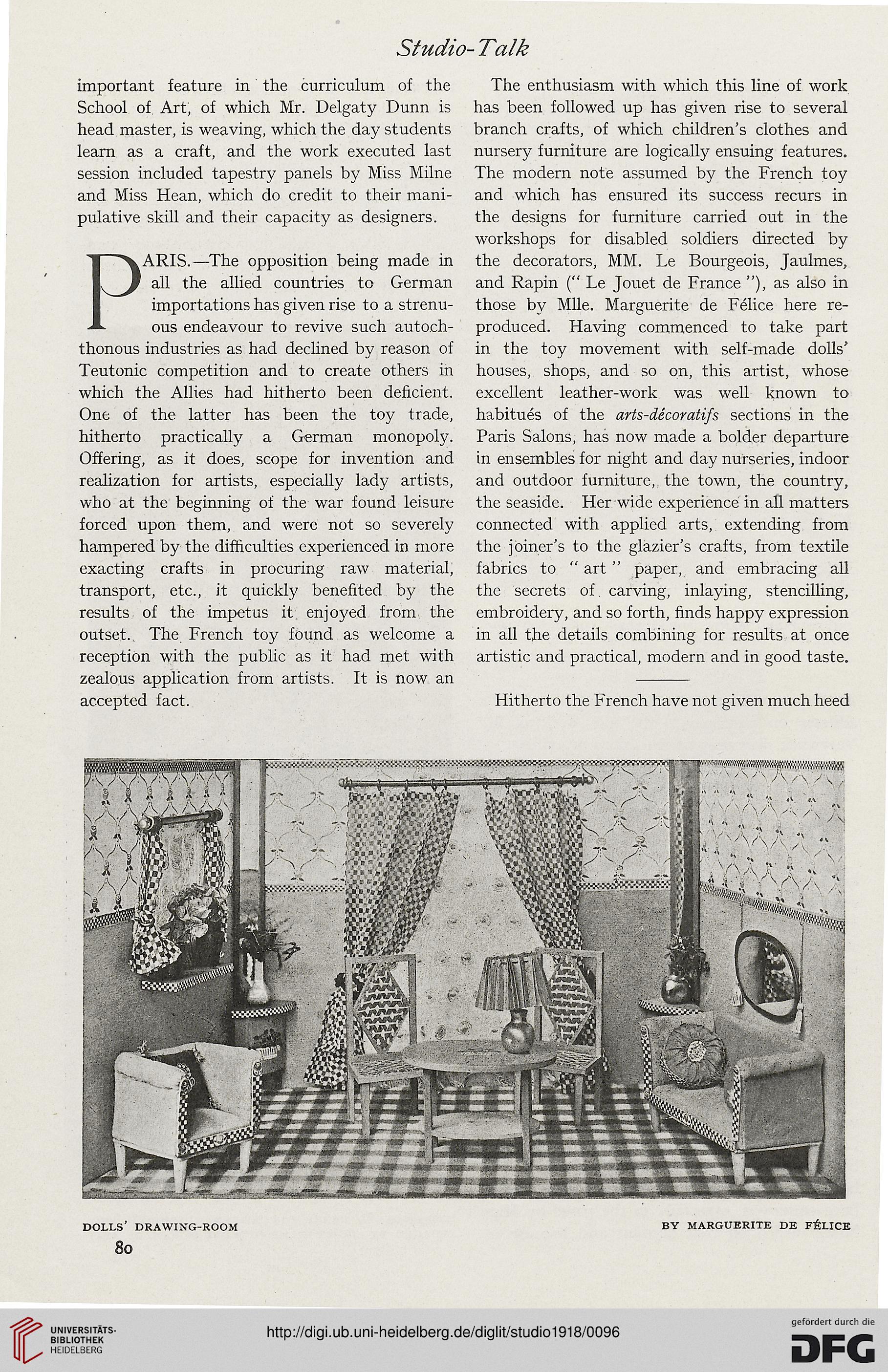Studio-Talk
important feature in the curriculum of the
School of Art, of which Mr. Delgaty Dunn is
head master, is weaving, which the day students
learn as a craft, and the work executed last
session included tapestry panels by Miss Milne
and Miss Hean, which do credit to their mani-
pulative skill and their capacity as designers.
PARIS.—The opposition being made in
all the allied countries to German
importations has given rise to a strenu-
ous endeavour to revive such autoch-
thonous industries as had declined by reason of
Teutonic competition and to create others in
which the Allies had hitherto been deficient.
One of the latter has been the toy trade,
hitherto practically a German monopoly.
Offering, as it does, scope for invention and
realization for artists, especially lady artists,
who at the beginning of the war found leisure
forced upon them, and were not so severely
hampered by the difficulties experienced in more
exacting crafts in procuring raw material,
transport, etc., it quickly benefited by the
results of the impetus it. enjoyed from the
outset. The French toy found as welcome a
reception with the public as it had met with
zealous application from artists. It is now an
accepted fact.
The enthusiasm with which this line of work
has been followed up has given rise to several
branch crafts, of which children’s clothes and
nursery furniture are logically ensuing features.
The modern note assumed by the French toy
and which has ensured its success recurs in
the designs for furniture carried out in the
workshops for disabled soldiers directed by
the decorators, MM. Le Bourgeois, Jaulmes,
and Rapin (“ Le Jouet de France ”), as also in
those by Mile. Marguerite de Felice here re-
produced. Having commenced to take part
in the toy movement with self-made dolls’
houses, shops, and so on, this artist, whose
excellent leather-work was well known to
habitues of the arts-decoratifs sections in the
Paris Salons, has now made a bolder departure
in ensembles for night and day nurseries, indoor
and outdoor furniture, the town, the country,
the seaside. Her wide experience in all matters
connected with applied arts, extending from
the joiner’s to the glazier’s crafts, from textile
fabrics to “ art ” paper, and embracing all
the secrets of carving, inlaying, stencilling,
embroidery, and so forth, finds happy expression
in all the details combining for results at once
artistic and practical, modern and in good taste.
Hitherto the French have not given much heed
dolls’ drawing-room
8o
BY MARGUERITE DE FELICE
important feature in the curriculum of the
School of Art, of which Mr. Delgaty Dunn is
head master, is weaving, which the day students
learn as a craft, and the work executed last
session included tapestry panels by Miss Milne
and Miss Hean, which do credit to their mani-
pulative skill and their capacity as designers.
PARIS.—The opposition being made in
all the allied countries to German
importations has given rise to a strenu-
ous endeavour to revive such autoch-
thonous industries as had declined by reason of
Teutonic competition and to create others in
which the Allies had hitherto been deficient.
One of the latter has been the toy trade,
hitherto practically a German monopoly.
Offering, as it does, scope for invention and
realization for artists, especially lady artists,
who at the beginning of the war found leisure
forced upon them, and were not so severely
hampered by the difficulties experienced in more
exacting crafts in procuring raw material,
transport, etc., it quickly benefited by the
results of the impetus it. enjoyed from the
outset. The French toy found as welcome a
reception with the public as it had met with
zealous application from artists. It is now an
accepted fact.
The enthusiasm with which this line of work
has been followed up has given rise to several
branch crafts, of which children’s clothes and
nursery furniture are logically ensuing features.
The modern note assumed by the French toy
and which has ensured its success recurs in
the designs for furniture carried out in the
workshops for disabled soldiers directed by
the decorators, MM. Le Bourgeois, Jaulmes,
and Rapin (“ Le Jouet de France ”), as also in
those by Mile. Marguerite de Felice here re-
produced. Having commenced to take part
in the toy movement with self-made dolls’
houses, shops, and so on, this artist, whose
excellent leather-work was well known to
habitues of the arts-decoratifs sections in the
Paris Salons, has now made a bolder departure
in ensembles for night and day nurseries, indoor
and outdoor furniture, the town, the country,
the seaside. Her wide experience in all matters
connected with applied arts, extending from
the joiner’s to the glazier’s crafts, from textile
fabrics to “ art ” paper, and embracing all
the secrets of carving, inlaying, stencilling,
embroidery, and so forth, finds happy expression
in all the details combining for results at once
artistic and practical, modern and in good taste.
Hitherto the French have not given much heed
dolls’ drawing-room
8o
BY MARGUERITE DE FELICE




